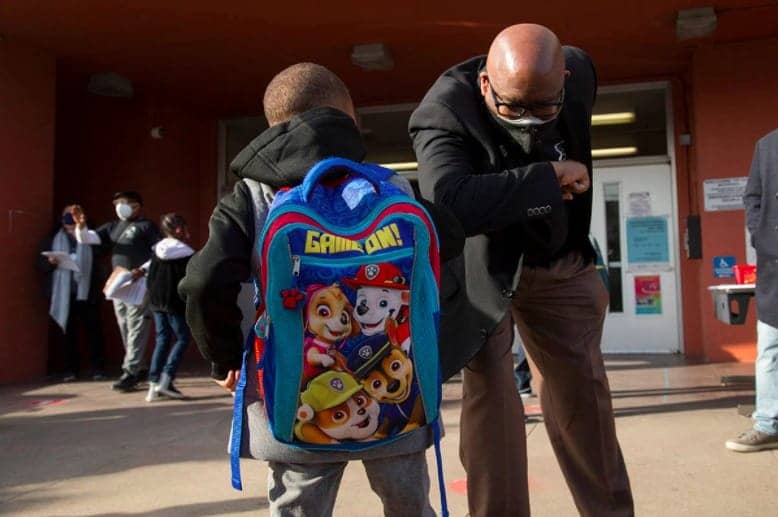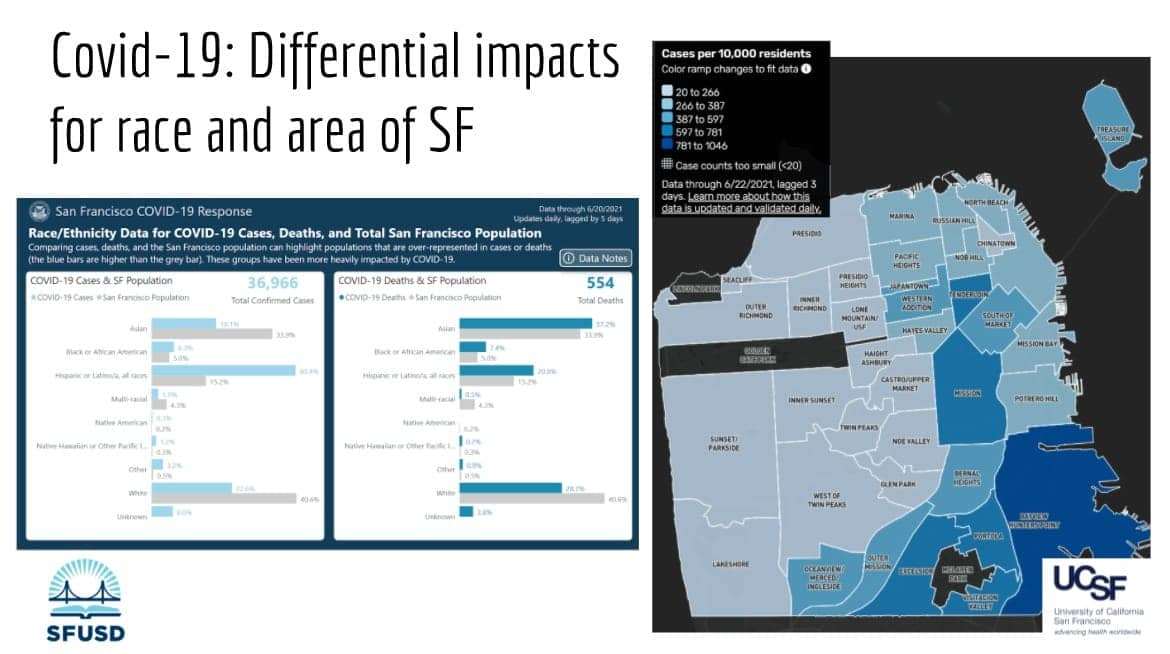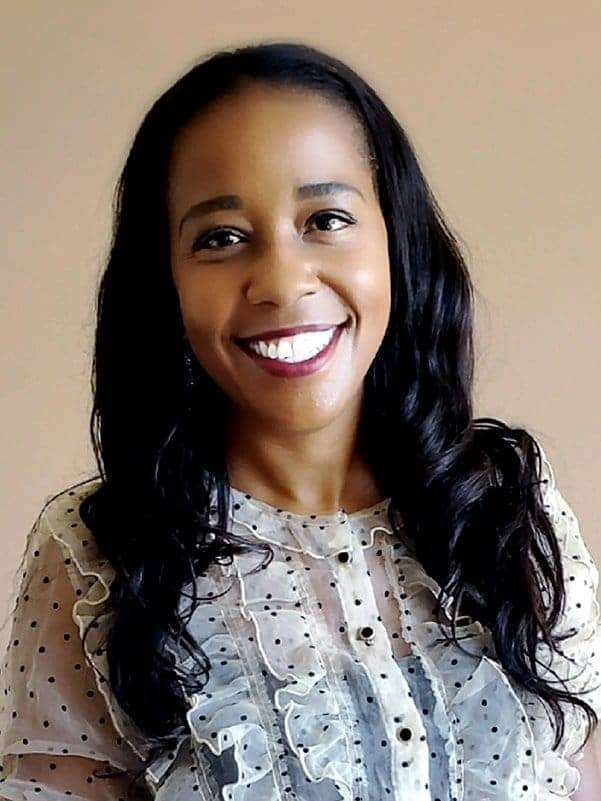
by Daphne Young, Education Reporter
As in-person learning is set to resume in the fall for most schools across the nation, the San Francisco Unified School District – California’s seventh largest school district – is working feverishly to ensure that families are ready and informed about SFUSD’s back-to-school plan. At the center of SFUSD’s school reopening plan is their partnership with health officials and medical experts from the University of California San Francisco.
During the July 6, 7 and 8 Multilingual Town Hall Information Sessions, UCSF doctors shared vital information about COVID-19 and those communities in San Francisco who were hardest hit. If you take a look at the chart below, you can see the most impacted communities included Bayview Hunters Point, Mission, Tenderloin, Western Addition, South of Market, Portola, Excelsior and Visitation Valley. These neighborhoods had the highest number of COVID-19 cases and deaths in San Francisco.

Recently, we caught up with Deputy Superintendent Enikia Ford-Morthel, who answered specific questions relating to the Bayview Hunters Point community and SFUSD’s overall back-to-school plan. Here’s Ford-Morthel’s responses to some of our questions.
Daphne Young: When you look at the COVID-19 Differential Impacts for Race and Area of San Francisco slides that were presented by UCSF experts at the Multilingual Town Hall meetings in July, it’s clear that the Bayview Hunters Point area was impacted the most by COVID-19 cases. So, what plans are in place to support SFUSD students from this community and others like it who are being severely impacted by the disease?
Enikia Ford-Morthel: Of course, SFUSD is here to support all the schools and all the students, and we know that there are some areas or communities where the need might be greater. The systemic issues of Bayview are close to my heart as the former Assistant Superintendent. And the fact that Bayview is right there on the map with a consistent pattern of health issues and disparities, especially during this pandemic, is upsetting.
Pre-pandemic, we started a program specifically for Bayview called Bayview Ignite. It’s a three-day institute where all staff and educators from schools in the Bayview come together to plan for the year. Bayview Ignite brings every adult from all the Bayview schools together to think about how this work is unique for the Bayview area and students.
We plan community walks and we look at data and see where there are gaps in learning, wellness and the uptick of COVID-19. We came up with a plan for how we can better support this community.
Our goal right now is to transition our students back into in-person learning. Through the recent Town Hall sessions and training, we continue to partner with UCSF and the Department of Public Health to reach out with families and ensure they understand the importance of getting vaccinated and tested for COVID-19.
There have been many mixed messages and a lot of anxiety among the African American, Latinx and Pacific Islander communities. So, we need more targeted information sessions for these groups who were the highest among those not getting tested or vaccinated. A more targeted touch is needed. Therefore, we are also partnering in Bayview with community partners like the YMCA and 100% College Prep, because these organizations are in regular communication with families.
Daphne: What’s being offered for families who decided to keep their children home in the fall? What will a day at school look like for those students?
Enikia: It’s our sincere hope that as many children as possible return to in-person learning in the fall. We do know that there are some families for whom this is just not possible. We will have an online program, but it’s really limited. Also, our plan to support wifi and connectivity continues.
We’ll continue to distribute devices and we’ve ramped up our efforts with wifi coverage. For families in our online learning program, we will have much more to offer them this year because since more students will be in-person, this will hopefully lighten up the wifi connectivity issues many students and households were having. Plus, we’ve created more tutorials and videos for families and students to assist them with tech and connectivity issues.
But parents who opt to keep their students at home need to understand that there is limited capacity for distance learning this year. There are also eligibility requirements and an enrollment process for the online learning program. For more information about SFUSD’s “limited” remote learning option, parents need to visit the Return to In-Person Learning Presentation from the June 22 SF Board of Education Meeting, page 15, to learn more. Registration is required for students.
There is no cost for school meals this year, which will include breakfast and lunch at all SFUSD schools. Suppers will also be available to after school programs at no cost to families.
Daphne: How will the mental health dollars from the City of San Francisco be allocated?
Enikia: In regards to mental health, SFUSD built up care teams during the pandemic. These teams were the ones who did wellness checks and offered other services. Many schools have wellness centers and social workers and we plan to keep our Resource Link Line. Plus, mental health dollars from the City of San Francisco will initially go towards three schools beginning in the fall.
Eventually, those funds will go to 13 middle schools and three K-8 schools that already have the Beacon After School program. SFUSD is also partnering with many after school programs across the city. So, visit the afterschool programspage to take a look at the many options available to families this fall. For parents who have to work or are getting back to work, it can come in handy to have after school options finally available again.
Daphne: Can you tell us about the revised free lunch program and why it will be available to all students in the fall?
Enikia: Parents, if you didn’t know, SFUSD will be offering free lunch to all students during the 2021-22 school year. Thanks to federal waivers, there is no cost for school meals this year, which will include breakfast and lunch at all SFUSD schools. Suppers will also be available to after school programs at no cost to families. So, we urge parents to take advantage of free school meals all year long.

Daphne: What about transportation services for students? Who’s eligible to ride SFUSD school buses in the fall?
Enikia: SFUSD, in partnership with transportation provider Zum Services Inc., will continue to provide safe and reliable transportation to and from school. The Transportation Team will provide curb-to-curb transportation for students with IEPs. As we continue to move through the latest developments and planning around COVID-19, the SFUSD Transportation Department would like to encourage all families of students receiving transportation services to register and activate their ParentVUE accounts and keep their contact information up to date.
Daphne: As we get closer to the start of school, what can each parent do to help support their child’s return to in-person learning?
Enikia: There are a number of things parents can do and these steps might seem pretty basic, but they will help get our students ready to go back to school in the fall:
- Check out the Return Safely Guide for Families on the SFUSD website. And, be sure to update your child’s emergency card for school. This is the very best way for your child’s school to stay in contact with your family.
- Visit your child’s school website regularly and SFUSD’s Student Family School Resource Link. This site supports students and families in navigating all of the resources available. You can email requests to sflink@sfusd.edu, call 415-340-1716 Monday-Friday, 9 a.m.-1 p.m., or complete an online request form.
- Plus, there’s a new weekly family newsletter, the Family Announcements Bulletin, or FAB, that will begin going out to families on Aug. 19. FAB will consist of select public announcements that span across schools. It will go out every Thursday afternoon. Be sure to stay updated.
- Know your child’s new bell school schedule. SFUSD has changed its school start times at all schools to give students and parents more consistent start times. So, students will have only 1-of-3 start times: 7:50 a.m., 8:40 a.m. or 9:30 a.m. SFUSD made this switch to make it easier for families during the pandemic, and we’ve found it best to lower the variety of start times across the district. Visit Fall Bell Schedules – 2021 to ensure that you know your child’s new start time.
- Start re-establishing your child’s routine. It only takes a short time to learn a new behavior and we’ve been out of school for 16 months. So, first and foremost start getting students back into a routine. Getting them dressed in the morning and setting earlier bedtimes, if possible, helps to get students back into a routine.
- Make sure students are reading! Visit your local library or website and get students back to doing what they will be doing at school or after school – reading and writing.
- Start talking to your student about going back to school. Ask them how they feel about going back to school and let them express themselves. Some students might be excited, while others may be anxious. In many cases, students haven’t even seen their school. For example, kindergarteners or middle school students may have never set foot in their new school. So, give them time to adjust. Ask them what they are thinking and see if they have any questions.
Parents, we know there’s a lot of information for you to digest as you prepare for the start of the school year for your child. But don’t forget there are many resources available. So, start with the sfusd.edu website and be sure to contact your child’s school directly. You can also email us at education@sfbayview.com if you have any questions about information presented in this story.
We’d like to thank Deputy Superintendent Enikia Ford-Morthel for taking the time to talk to the SF Bay View about some of the challenges facing SFUSD students and families this coming school year. The SFUSD deputy superintendent has agreed to meet with us again soon to further discuss more details about services for Special Needs students and tell us what plans are in place to better meet all students’ mental health needs as they return to in-person learning during this pandemic. Visit www.sfbayview.com for updates on SFUSD’s back-to-school plans!
Daphne Young is the Education Reporter at the San Francisco Bay View National Black Newspaper. The Chicago native is an award-winning journalist who’s covered news for radio and TV stations around the country. She attended San Francisco State University and is a member of Delta Sigma Theta Sorority, Inc. If you have an education story that you’d like to see the Bay View cover, please contact Daphne by email: education@sfbayview.com.





